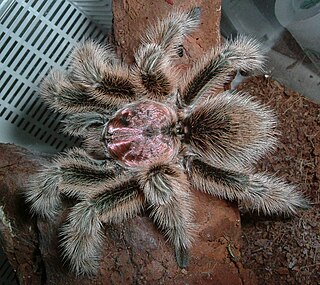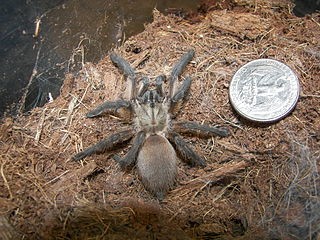
Grammostola is a genus of South American tarantulas that was first described in text by Eugène Louis Simon in 1892. These medium- to large-sized spiders are native to tropical South America, and are usually brown in color, with pinkish or orangish-red hairs. The very docile Chilean rose tarantula is popular as a beginner's spider among tarantula enthusiasts.

Barychelidae, also known as brushed trapdoor spiders, is a spider family with about 300 species in 39 genera.

Selenocosmia is a genus of tarantulas that was first described by Anton Ausserer in 1871. The genus is found in China, New Guinea, Australia, Indonesia, Myanmar, Malaysia, Laos, Vietnam, Philippines, India and Pakistan. They are commonly referred to as whistling or barking spiders, due to their ability to stridulate using lyra hairs.

Tarantulas comprise a group of large and often hairy spiders of the family Theraphosidae. As of December 2023, 1,100 species have been identified, with 166 genera. The term "tarantula" is usually used to describe members of the family Theraphosidae, although many other members of the same infraorder (Mygalomorphae) are commonly referred to as "tarantulas" or "false tarantulas". Some of the more common species have become popular in the exotic pet trade. Many New World species kept as pets have setae known as urticating hairs that can cause irritation to the skin, and in extreme cases, cause damage to the eyes.

Idiops is a genus of armored trapdoor spiders that was first described by Josef Anton Maximilian Perty in 1833. It is the type genus of the spurred trapdoor spiders, Idiopidae. Idiops is also the most species-rich genus of the family, and is found at widely separated locations in the Neotropics, Afrotropics, Indomalaya and the Middle East. Females live in tubular burrows lined with a thick layer of white silk. These typically have a D-shaped lid that fits into the entrance like a cork, and some burrows have two entrances. The lid may consist of mud, moss or lichen, which is bound below by a thick layer of silk. As in all genera of this family, the anterior lateral eyes (ALE) are situated near the clypeal margin, far in front of the remaining six eyes, which are arranged in a tight group. The males which are smaller in size, wander about or occasionally live in burrows. Like other mygalomorphs, they are relatively large and long-lived. Forest clearance and agricultural practices that loosen the soil and enhance erosion, besides soil removal for brick making have been pointed out as serious threats to some Indian species. Species ranges are poorly known – in India for instance, most species are known only from their type localities.
Scalidognathus is a genus of Asian armored trapdoor spiders that was first described by Ferdinand Anton Franz Karsch in 1892. Originally placed with the Ctenizidae, it was moved to the Idiopidae in 1985.

Ephebopus is a genus of northeastern South American tarantulas that was first described by Eugène Louis Simon in 1892. Its relation to other tarantulas is one of the most uncertain in the family, and it has been frequently moved around and has been placed in each of the eight subfamilies at least once.

The Aviculariinae are a subfamily of spiders in the family Theraphosidae (tarantulas). They can be distinguished from other theraphosids by a number of characters. Their legs have no or few spines on the underside of the tibial and metatarsal joints of the legs. The last two leg joints have brushes of hairs (scopulae) that extend sideways, particularly on the front legs, giving them a spoon-like (spatulate) appearance. Females have two completely separated spermathecae.

Neoheterophrictus is a genus of tarantula in the family Theraphosidae. It comprises 8 species, all found in India.

The Eumenophorinae are a subfamily of tarantula spiders. They are known from genera distributed across Sub-Saharan Africa, the south of the Arabian peninsula, Madagascar and its associated islands, and parts of India.
Neoheterophrictus madraspatanus is a species of spider in the family Theraphosidae, found in India.

Chilobrachys is a genus of Asian tarantulas that was first described by Ferdinand Anton Franz Karsch in 1892. They are found in India, Myanmar, Malaysia, China, Vietnam, Thailand and Sri Lanka. They are usually medium or large-sized, and they can stridulate by using small spines present on the chelicerae.
Plesiophrictus is a genus of tarantulas that was first described by Reginald Innes Pocock in 1899.
Tigidia is a genus of brushed trapdoor spiders first described by Eugène Simon in 1892.
Coremiocnemis is a genus of tarantulas that was first described by Eugène Louis Simon in 1892. They are named after the greek words korema, which means broom or brush, and kemis, meaning shin guard. Being a reference to the hirsute characteristics of the posterior legs.

Cyrtopholis is a genus of tarantulas that was first described by Eugène Louis Simon in 1892.

Lampropelma is a genus of Indonesian tarantulas that was first described by Eugène Louis Simon in 1892. As of March 2020 it contains two species, found in Indonesia.
Sahydroaraneus is a genus of spiders in the family Theraphosidae. It is found in India and was first described in 2014 by Mirza & Sanap.

Cilantica is a genus of Indian tarantulas that was described by Mirza in 2024.Two members from Haploclastus were transferred into the genus along with one new species. They are only found in the Palakkad Gap.












